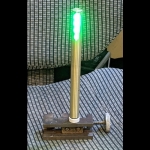This project is a bit of an exercise in extreme absurdity Ė which is precisely why itís so much fun!
The problem: when backing my truck to hitch up my boat trailer, I canít see the dang hitch. Itís obviously not visible in mirrors when getting closer than a couple of truck lengths, and the rear view camera on my Toyota Tacoma is so wide-angle the hitch looks like itís in another county until Iím almost too close to correct Ė and in addition, if it is in deep shadow on a bright day I flat canít see it. Might be old eyes with less tolerance for high contrast scenes, since I donít recall having this much trouble back when I went fishing by day-tripping from my back yard. Oh, wait, now I remember: I never unhitched! The boat was hitched to the truck from May thru October. Now at the lake I unhitch because we only have one vehicle there and donít want to drag the boat when we go to town for provisions. We had to launch and retrieve for every fishing outing after mid-August this summer because the lake was so low I couldnít get the boat on and off the lift.
I have an aid I bought at Harbor Freight many years ago that sorta works: itís basically a chartreuse foam ball on a telescoping tube like a car radio aerial, attached to a magnet. With the magnet set on the hitch, the ball is high enough to see in the inside mirror. That works OK but the flimsy telescoping tube keeps breaking, and it still takes two or three tries because seeing a tennis ball in the inside mirror isnít precise enough to put the ball RIGHT under the hitch so itíll drop on when I unwind the tongue jack.
The Tacomaís rear view camera, useless as it is at ranges much more than armsí length or when the hitch is in deep shadow on a bright summer day, is wonderful for getting the ball RIGHT under the hitch if I can get it in the general neighborhood some other way.
I thought Iíd make a beacon that I could see even in shadow and even from yonder with the Tacomaís myopic rear view camera. I used narrow-angle-of-view green LEDs: narrow angle so theyíd look very bright from any angle that matters when backing to hitch up, green because thatís the color most visible to the human eye. Just for fun, I decided to try to run them with a single 1.5 volt AA penlight cell, though four green LEDs require about 13 volts to operate. I made a dirt simple circuit to goose up the voltage. Itís one transistor, one resistor and a shopmade transformer smaller than half of a gumdrop. I threw in a diode and capacitor to soup it up a little, but those were optional.
I housed it in a piece of brass tubing that I happened to have in the goodie box. It is just the right internal diameter to house an AA cell. I found a tail cap on-off switch from a Chinese penlight-cell flashlight in my electronix goodie box. It had M0.9 mm metric threads of just the right diameter (well duh, from a penlight flashlight!). My lathe canít make M0.9 mm threads, but it can make 28 threads-per-inch imperial threads that are close enough (within 7% or so) to work with short engagement of only 3 threads.
Iíve omitted some details that had me scratching my head and various other Ö well, puzzling, anyway, like how to get the internal circuit board electrically connected to the brass tube which is connected to the negative side of the AA cell via the tailcap switch. That solution was a bit of stainless, or maybe nickle-plated, spring wire from who knows what cannibalized electronic gizmo. Floppy drive from 1978?
So, here it is!
I can't figure out how to get the photos to display here with correct orientation.
The white ring on the bottom is a surprisingly strong donut magnet from Ax-Man surplus (35 cents) epoxied to the tail cap switch. The little dimple about amidships on the tube is a #4-40 set screw that holds the delrin internal battery positive contact insulator plug in place. It was a press fit when I made it, but when I pressed it in the threads in the tail cap end of the tube scraped it down to a loose fit. So why didnít I press it in from the other end? Who knew, right?
The top cap is just a brass plug turned to .001Ē larger than the ID of the tube and encouraged into place with a plastic-faced hammer. This device is not user-servicable: endcap can be removed with explosives.
When not in use for hitching up the trailer, it can be used as a club for stunning nasty toothy northern pike caught while fishing.


 LinkBack URL
LinkBack URL About LinkBacks
About LinkBacks


 Reply With Quote
Reply With Quote



Bookmarks